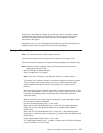unrecovered data errors, recovered data errors, recovered and unrecovered
equipment errors exceed the threshold values, the disk needs to be replaced.
It also makes 2000 random seeks after the read certify of the surface completes. If a
disk timeouts before finishing the random seeks, then the disk needs to be replaced.
The random seeks also count all errors encountered.
The Certify service aid will display the following information:
– Drive capacity in megabytes.
– Number of Data Errors Recovered.
– Number of Data Errors Not Recovered.
– Number of Equipment Checks Recovered.
– Number of Equipment Checks Not Recovered.
This task can be run directly from the AIX command line. See the following command
syntax: diag -c -d
deviceName
-T "certify"
Flag Description
-c No console mode
-d Specifies a device
-T Specifies the certify task
v Format and/or Erase Hardfile Attached to a Non-RAID SCSI Adapter
Attention: The following commands WILL change the content of the hardfile. Be
sure to backup data prior to running the command, and take care in choosing the
hardfile upon which you run this task.
– Hardfile Format
Writes all of the disk. The pattern written on the disk is device-dependant; for
example, some drives may write all 0s, while some may write the hexadecimal
number 5F. No bad block reassignment occurs.
– Hardfile Format and Certify
Performs the same function as Hardfile Format. After the format is completed,
Certify is run. Certify then reassigns all bad blocks encountered.
– Hardfile Erase Disk
This option can be used to overwrite (remove) all data currently stored in
user-accessible blocks of the disk. The Erase Disk option writes one or more
patterns to the disk. An additional option allows data in a selectable block to be
read and displayed on the system console.
To use the Erase Disk option, specify the number (0-3) of patterns to be written.
The patterns are written serially; that is, the first pattern is written to all blocks.
Then the next pattern is written to all blocks, overlaying the previous pattern. A
random pattern is written by selecting the Write Random Pattern option.
Note: The Erase Disk service aid has not been certified as meeting the
Department of Defense or any other organization’s security guidelines.
Use the following steps to overwrite the data on the drive:
1. Use the Erase Disk selection to overwrite the data on the drive.
98 Eserver pSeries 690 User’s Guide


















